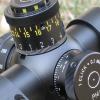henschman
Member
I am considering a Leatherwood/Hi-Lux ART Camputer M-1000 2.5-10x44 scope for mounting on a Savage 111 .300 Win Mag rifle. It will be used in a sniper/long range precision role.
Do any of you have any experience with this scope? If you do, I would be interested in hearing your opinions on it.
I would like an optic that allows for very quick ranging and trajectory compensation for use on man-sized targets at unknown distances, so that it can be used to quickly and effectively get 1st shot hits in a high-stress situation where there is little time to range and adjust.
I am considering this optic because it seems to fit the bill. For those that don't know, it has a cam connected to the magnification dial, so that it increases elevation as you increase magnification. The cam is adjustable to match your load. The idea is that you "zoom in" on the target until an 18" wide space on the target is bracketed in the reticle, which automatically gives you the proper elevation adjustment for the target's range. Since the average man is around 18" wide shoulder-to-shoulder, you just have to bracket the target and shoot. The scope is set so that it adjusts 1x for every 100m, so it is capable of automatically ranging anywhere from 250 to 1000m.
It sounds like it would be very quick and requires no calculations, which would be ideal for use under stress. I am interested to know if it works as well as is advertised.
I also understand that, unlike the older ART's from the Vietnam era, this scope is made in China. However, also unlike the older ART, this one has an adjustable cam that can be set for different calibers or hand-loads, rather than having to buy a different cam for every load. I'm sure there is much higher quality glass out there, but I'm mostly interested in this scope for the cam feature. The price is also pretty tempting at around $350.
Any input on the functionality and quality of this scope from people who have actual experience with it would be much appreciated.
Do any of you have any experience with this scope? If you do, I would be interested in hearing your opinions on it.
I would like an optic that allows for very quick ranging and trajectory compensation for use on man-sized targets at unknown distances, so that it can be used to quickly and effectively get 1st shot hits in a high-stress situation where there is little time to range and adjust.
I am considering this optic because it seems to fit the bill. For those that don't know, it has a cam connected to the magnification dial, so that it increases elevation as you increase magnification. The cam is adjustable to match your load. The idea is that you "zoom in" on the target until an 18" wide space on the target is bracketed in the reticle, which automatically gives you the proper elevation adjustment for the target's range. Since the average man is around 18" wide shoulder-to-shoulder, you just have to bracket the target and shoot. The scope is set so that it adjusts 1x for every 100m, so it is capable of automatically ranging anywhere from 250 to 1000m.
It sounds like it would be very quick and requires no calculations, which would be ideal for use under stress. I am interested to know if it works as well as is advertised.
I also understand that, unlike the older ART's from the Vietnam era, this scope is made in China. However, also unlike the older ART, this one has an adjustable cam that can be set for different calibers or hand-loads, rather than having to buy a different cam for every load. I'm sure there is much higher quality glass out there, but I'm mostly interested in this scope for the cam feature. The price is also pretty tempting at around $350.
Any input on the functionality and quality of this scope from people who have actual experience with it would be much appreciated.



